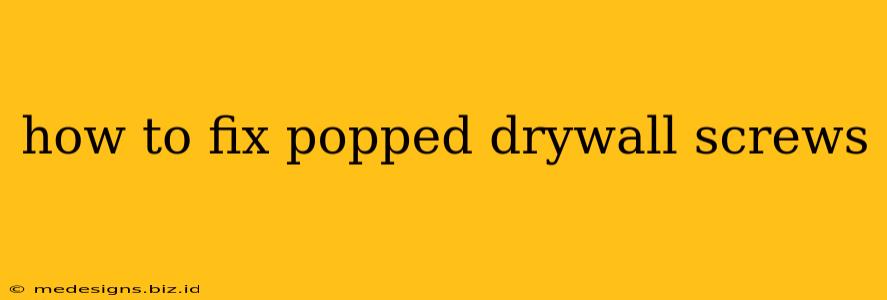Drywall screws popping out is a common household problem, often appearing as unsightly bumps on your walls. This annoying issue can be caused by several factors, including settling foundations, normal house settling, drywall expansion and contraction, or simply inadequate fastening during installation. Fortunately, fixing popped drywall screws is a relatively easy DIY project that can significantly improve the aesthetic appeal of your home. This guide will walk you through the process step-by-step.
Identifying the Cause of Popped Drywall Screws
Before you start repairing, it's helpful to understand why your screws are popping out. This will help you prevent the problem from recurring. Some common causes include:
- House Settling: As your house ages, minor settling is normal and can put stress on the drywall, causing screws to loosen and pop.
- Drywall Expansion and Contraction: Changes in temperature and humidity can cause drywall to expand and contract, leading to popped screws.
- Improper Installation: Screws that weren't driven in deep enough during initial installation are more prone to popping out.
- Movement in the Structure: Significant structural movement, such as foundation issues, can also cause this problem. If you notice extensive popping, consult a structural engineer.
Tools and Materials You'll Need
Before starting your repair, gather the necessary tools and materials:
- Drywall Screws: Choose screws slightly longer than the original ones. Using slightly longer screws helps ensure a stronger hold.
- Screwdriver (Phillips Head): A good quality screwdriver that fits your screws snugly will make the job easier and prevent stripping.
- Putty Knife: Use a putty knife to apply spackle. A 2-inch or 3-inch knife is ideal for most repairs.
- Spackle or Joint Compound: This will fill the holes left by the popped screws and provide a smooth finish.
- Sandpaper: Fine-grit sandpaper (120-grit or higher) is needed to smooth the spackle after it dries.
- Primer: Prime the repaired area to ensure the paint adheres properly.
- Paint: Match the existing wall paint to ensure a seamless finish.
- Measuring Tape: Measure to ensure proper screw placement.
- Optional: Drywall Tape: If there are significant gaps, adding drywall tape can reinforce the repair.
Step-by-Step Guide to Fixing Popped Drywall Screws
1. Assess the Damage: Examine each popped screw to determine the extent of the damage and if there are any cracks around the screw head.
2. Remove the Loose Screw: Carefully remove the popped screw using a screwdriver. If the screw is stripped, you may need pliers to remove it.
3. Prepare the Hole: If the hole is enlarged, consider using a slightly larger screw. Clean out any loose debris from the hole.
4. Install the New Screw: Use a new, slightly longer screw and drive it in at a slight angle to get a better bite. Do not overtighten, as this could cause the drywall to crack. Make sure it is flush with the surface of the drywall.
5. Apply Spackle or Joint Compound: Use your putty knife to apply spackle to the hole, feathering the edges to create a smooth transition with the surrounding wall.
6. Let it Dry: Allow the spackle to dry completely according to the manufacturer's instructions. This usually takes several hours.
7. Sand the Repair: Once dry, use fine-grit sandpaper to smooth the spackled area until it's flush with the wall. Be gentle to avoid creating scratches.
8. Prime and Paint: Apply a coat of primer to the repaired area. Once the primer is dry, apply paint that matches the existing wall color. Two thin coats are usually better than one thick coat.
Preventing Popped Drywall Screws
To prevent this frustrating issue from reoccurring, consider these preventative measures:
- Proper Installation: Ensure drywall is properly installed with sufficient fasteners during the initial installation.
- Climate Control: Maintain consistent temperature and humidity levels in your home to minimize expansion and contraction of the drywall.
- Address Foundation Issues: If you suspect foundation problems, consult a structural engineer to address any underlying issues.
By following these steps, you can effectively repair popped drywall screws and restore the smooth, clean look of your walls. Remember, patience and attention to detail will produce professional-looking results.
